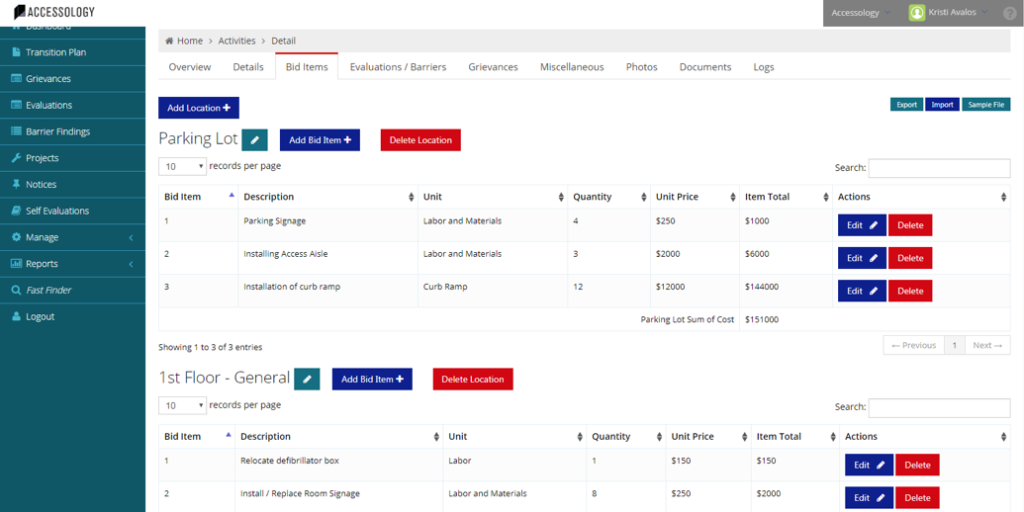Accessology utilizes AIMS (Accessology Information Management System) which is an ADA inspection and compliance software system developed by Technicate Solutions as our data collection tool. AIMS is a cloud-hosted system for management of accessibility evaluations. All facility evaluations are input into the software by way of a mobile application which then syncs to our dedicated server. The data is then analyzed and manipulated in our dedicated web portal.


A core functionality of the AIMS solution we use is in the evaluation module, which enables us to conduct thorough site and public rights-of-way (PRoW) inspections. Since data has already been collected, we are able to interpret the data and input it into the system easily, depending on the format in which we get the data.
AIMS’s solution incorporates geolocation via the Google Maps API for all data types that include geospatial data. The familiar features of Google Maps are available within AIMS. Geolocation data can be recorded on site by use of the mobile application as well as within the web portal interface from the data we receive.
AIMS has over 70 federal, state, and regional barrier standards embedded in the software so it can compare ADA and TAS standards to ensure compliance with both the state and federal requirements at the same time. We can also set it to evaluate to any other access related standard or code, such as ANSI A 117 and/or IBC.
In the event our client were to receive an inquiry from an enforcement body (such as the DOJ) or a civil lawsuit arises, AIMS’s system provides a full log of every communication attempt, letter sent, action taken, and so on. This auditable set of documentation is a central feature of AIMS’s strength.
The document sections in the Transition Plan builder include:
- Introduction – This section covers ADA general info, history, and Title II requirements.
- Official Responsible – This section identifies the agency’s ADA Coordinator.
- Public Involvement – This section describes public involvement measures and allows the agency to upload any public comments received for its draft Transition Plan and incorporates them with the final draft.
- Inventory/Discovery Efforts – This section describes inventory efforts and can automatically build a table of assets from data found in the Evaluations module.
- Methodology – This section describes the methods used to identify and prioritize barriers.
- Barrier Removal – This section discusses how and when field surveys began, prioritization of the barriers identified, scheduling and quality control of remediation efforts, and the process and methods of barrier removal.
We can also include a link to a live map of identified barriers for the public to see. This link enables the Transition Plan to be “living,” in that up-to-the-minute barrier information can be viewed on demand. Placing the link on the client’s public website allows citizens to view all barriers on demand, both open and resolved. As the client updates barriers, the public can see the progress being made toward compliance. Only the information that has been approved for public view is made available in this public-facing map. All data made public can be searched and sorted by column, and the search box above the map allows searching for barriers by street address.
The most effective tool for this project is AIMS’s approach to Title II compliance, which encompasses barrier identification, remediation, and status and can take a project from data collection through remediation and re-inspections, if needed. The Remediation module is designed to track previously found barriers through all phases of construction solutions.
Each barrier can be set up as a project for barrier remediation and a timeline developed for full resolution. The Remediation effectively helps manage barrier remediation, handle bid items, and document the work being completed.
For example: If the Transition Plan indicates that a route on a PRoW containing barriers will be fixed in five years, when the barrier is initially recorded in AIMS, a remediation project is created and linked to the barrier. The remediation project is given a start date that is four years or so in the future. When the start time for the project draws near, a reminder will appear on the dashboard calendar indicating that the project is an upcoming task.
Management of remediation projects in AIMS is especially helpful when our client must review and establish a budget and work schedule for a new fiscal year. For instance, if the agency is unable to begin a particular remediation in a given year for financial or other reasons, the remediation date on the barrier can be changed and the change will be automatically reflected in the agency’s Transition Plan.
Nothing gets forgotten. Nothing falls through the cracks. With AIMS, our team and the client’s team are able to keep track of everything.
